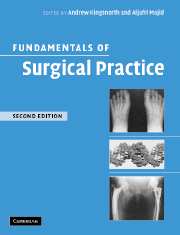Book contents
- Frontmatter
- Contents
- Preface
- Contributors
- 1 Preoperative management
- 2 Principles of anaesthesia
- 3 Postoperative management
- 4 Nutritional support
- 5 Surgical sepsis: prevention and therapy
- 6 Surgical techniques and technology
- 7 Trauma: general principles of management
- 8 Intensive care
- 9 Principles of cancer management
- 10 Ethics, legal aspects and assessment of effectiveness
- 11 Haemopoietic and lymphoreticular systems: anatomy, physiology and pathology
- 12 Upper gastrointestinal surgery
- 13 Lower gastrointestinal surgery
- 14 Hernia management
- 15 Vascular surgery
- 16 Endocrine surgery
- 17 The breast
- 18 Thoracic surgery
- 19 Genitourinary system
- 20 Head and neck
- 21 The central nervous system
- 22 Musculoskeletal system
- 23 Paediatric surgery
- Index
8 - Intensive care
Published online by Cambridge University Press: 15 December 2009
- Frontmatter
- Contents
- Preface
- Contributors
- 1 Preoperative management
- 2 Principles of anaesthesia
- 3 Postoperative management
- 4 Nutritional support
- 5 Surgical sepsis: prevention and therapy
- 6 Surgical techniques and technology
- 7 Trauma: general principles of management
- 8 Intensive care
- 9 Principles of cancer management
- 10 Ethics, legal aspects and assessment of effectiveness
- 11 Haemopoietic and lymphoreticular systems: anatomy, physiology and pathology
- 12 Upper gastrointestinal surgery
- 13 Lower gastrointestinal surgery
- 14 Hernia management
- 15 Vascular surgery
- 16 Endocrine surgery
- 17 The breast
- 18 Thoracic surgery
- 19 Genitourinary system
- 20 Head and neck
- 21 The central nervous system
- 22 Musculoskeletal system
- 23 Paediatric surgery
- Index
Summary
CARDIOVASCULAR SYSTEM
Cardiac anatomy
The heart has four chambers, four valves, and specialized conduction tissue. It is generally referred to as having left and right-sided chambers, but in humans the interatrial septum and inter-ventricular septum are located in a plane some 45° from the sagittal plane (Fig. 8.1). The right atrium and ventricle are therefore located anterior and to the right of the corresponding left atrium or ventricle. It is useful to bear this in mind when visualizing the cardiac chambers through echocardiograms (ECHO) or when assessing traumatic injuries to the chest wall.
Cardiac valves
The aortic and pulmonary valves are similar in structure and function, and consist of three components:
three-valve leaflets or cusps;
a three pronged fibrous annulus;
three dilations of the aortic/pulmonary wall (sinuses of Valsalva)
The aortic valve leaflets are referred to by clinicians as the left coronary, right coronary, and non-coronary leaflets. The fibrous annulus is shaped like a three-pronged coronet from which the valve leaflets are suspended. Valve stenosis may arise when the valve leaflets are fused or stiff and the annulus narrows; valve incompetence results from abnormalities of the valve leaflets and/or dilation of the annulus. The sinuses of Valsalva are important for initiating valve closure. They prevent the valve leaflets from being pressed flat against the aortic wall during systole, and eddy currents within the sinuses help initiate valve closure in diastole.
- Type
- Chapter
- Information
- Fundamentals of Surgical Practice , pp. 111 - 148Publisher: Cambridge University PressPrint publication year: 2006

